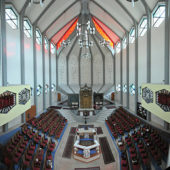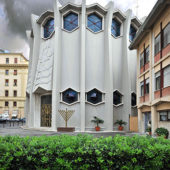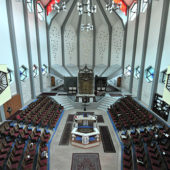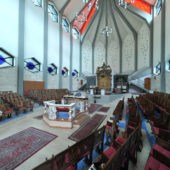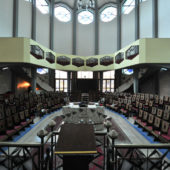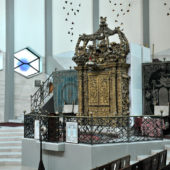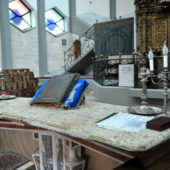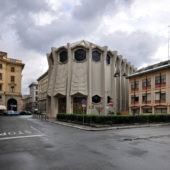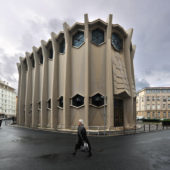Livorno’s current synagogue, centrally located in a city square, replaces the synagogue built there in the late 16th century that was destroyed in World War II.
Jews have a very long history in Italy, going back to the 2nd century BCE, when Israelites left Israel to go to Rome. However, it was not until the 16th century that the Jews migrated as far as Livorno, in Tuscany, a major port on the west coast of Italy. Ferdinand I (1507-1603) offered asylum to many minorities, including Jews, granting them rights and privileges. He offered them religious freedom, amnesty from previous crimes and full Tuscan citizenship. Jews were not required to live in ghettos; they could own horses, slaves, carry arms, open shops and study at the University. As a result of these liberties, the Jewish population grew from 114 in 1601 to over 3,000 in 1689. Jews rapidly became the nationality contributing the most to the society in Livorno.
Jews were involved in a wide range of businesses, ranging from physicians and merchants, to slave traders and money changers. Jewish influence not only affected nearly all civic life in Livorno, but extended throughout Europe and the Mediterranean. One specialized industry was the coral industry. Jews exported their coral products to Russia and India, where the coral was then used to make ritual objects. In 1632 Jews were the first to import coffee into Italy and coffeehouses were opened in Livorno. In 1659, Jews in Livorno started the city’s first printing press and published a midrash (commentary) on the Torah.
During the reign of Leopold I (1745-1790), Jews’ privileges were increased, to include the right to representation on the municipal council. In 1765, Louis XIV, King of France, offered to resettle the entire community of Livorno to Marseilles, France. However, the community turned down his offer. The Jewish community had complete jurisdiction of its people in both civil and criminal cases. In 1593 a special judge was assigned to the Jewish court; however, this policy was abolished in 1808, when Tuscany was incorporated into the French empire.
By the end of the 18th century, there were approximately 5,000 Jews in Livorno. The Jewish community of Livorno was considered for some time, the foremost ethnic group because of the wealth, scholarship and political rights of its members. After Napolean invaded Livorno in 1796, most of the rights and privileges the Jews had acquired were taken away and the community rapidly declined. By the end of the 19th century, the Jewish population of Livorno had dwindled to approximately 2,500 people. Today, there are approximately 600 Jews in Livorno, many of whom are natives, although approximately 300 Libyan Jews joined the community in 1967. The congregation is active and incorporates a kindergarten, Talmud Torah, museum, rabbinical college, as well as sponsors lectures, concerts, conferences and exhibits into its program.
The Jews of Livorno suffered no persecution, nor were there restrictions placed on them, the entire time they lived in the city until the fascists arrived during WWII. Their industry, ambition, and connections with the East, contributed to the commerce and industry of city. Thus, Livorno grew from a small fishing village into a rich, powerful commercial center, in large part thanks to the Jewish community. The Jewish community was comprised largely of Spanish and Portuguese immigrants and their ancient traditions have been practiced generation after generation, even today, in the Orthodox synagogue.
In 1548 the first synagogue in Livorno was in a room of one of a congregant’s home. The congregation met in various homes until a permanent synagogue was built in 1603. Due to the increasing size of the congregation, the synagogue was continually enlarged and embellished until 1789. Grand dukes and other foreign leaders visited the synagogue and it was admired throughout Europe for its splendor. It was a model for the synagogue in Amsterdam, which still exists today. The Rabbinate of Livorno was widely known for its scholarship. Many of the merchants delved into study of medicine, astronomy, philosophy, the classics, and Jewish science. In 1927 the synagogue became home to Italy’s first museum of Hebrew art. However, the synagogue, together with most of the city, was destroyed in WWII.
Construction for the new synagogue began in 1962 and was completed in September of 2003, on the site of the former synagogue. It is a modern structure, reminiscent of a two-storey ark, with six-sided windows closely aligned on both floors. Inside the massive white prayer room, gray ribs rise from the floor to the ceiling, every few feet along the walls, with a six-sided, colored windows placed in between the ribs, both upstairs and downstairs, casting colored light inside. The bimah is situated near the front third of the room on a small platform, with a surrounding white and tan balustrade, opening at the sides. A large tivah (reader’s desk) is placed inside. At the far end of the sanctuary, up a higher platform, is the magnificent and intricately hand-carved Aron Kodesh in antique gold. Pillars are carved into the sides, which support a crown-type of edifice above, with closed doors below, which house the Torah scrolls. The ceiling over the Aron Kodesh is painted gray, with sparkles below, resulting in the illusion of sparkles raining down over the ark. A tall, free-standing pewter menorah stands on the ground floor in front of the platform. Modern, circular chandeliers drop down from the ceiling to light the prayer room. Oriental rugs line the aisles and fixed, simply carved wood seating with maroon upholstery fill the sanctuary. The synagogue also houses Jewish archives and the offices of various Jewish organizations.

